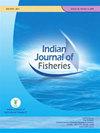评价三种饲料形式对室外水箱饲养的罗氏虎(Hamilton, 1822)幼鱼生长和存活的影响
IF 0.3
4区 农林科学
Q4 FISHERIES
引用次数: 0
摘要
进行了为期90天的饲养试验,以研究三种形式的饲料(面团、下沉和漂浮饲料)对rohu Labeo rohita(Hammilton,1822)幼鱼生长性能和存活率的影响。450只幼鱼(平均重量8.7±0.7g,平均长度9.68±0.37cm)被随机分配到9个大型室外混凝土池(50m2)中,分为三个处理,每个处理三个重复。由相同数量的配料制备的三种形式的日粮,即T1(面团饲料)、T2(沉降颗粒)和T3(漂浮颗粒),每天两次以8%的生物量喂养。研究结果显示,沉降颗粒饲料组的增重、比生长率(SGR)和饲料转化率(FCR)显著较高(p 0.05)。尽管已知罗湖从柱状区到底部区进食,但目前的研究结果表明,沉降颗粒比面团或漂浮形式更能改善该物种在幼鱼饲养过程中的生长性能。关键词:条件因子,饲料形态,生长发育,白暨豚,水质,产量本文章由计算机程序翻译,如有差异,请以英文原文为准。
Evaluation of three forms of feed on growth and survival of rohu Labeo rohita (Hamilton, 1822) juveniles reared in outdoor tanks
A feeding trial for 90 days duration was conducted to study the efficacy of three forms of feed (dough, sinking and floating feeds) on growth performance and survival of rohu Labeo rohita (Hammilton, 1822) juveniles. Four hundred and fifty fingerlings (average weight 8.7±0.7 g, average length 9.68±0.37 cm) were randomly distributed into nine large outdoor concrete tanks (50 m2 ), grouped into three treatments with three replicates each. Three forms of diet designated as T1 (dough feed), T2 (sinking pellets) and T3 (floating pellets), prepared from the same quantity of ingredients, were fed at 8% of biomass twice a day. The results revealed significantly higher weight gain, specific growth rate (SGR) and lower feed conversion ratio (FCR) in sinking pellet fed group (p 0.05). Though rohu is known to feed from column to bottom zones, the present results revealed better efficacy of sinking pellet over dough or floating form to improve the growth performance of the species during juvenile rearing. Keywords: Condition factor, Feed form, Growth, Labeo rohita, Water quality, Yield
求助全文
通过发布文献求助,成功后即可免费获取论文全文。
去求助
来源期刊

Indian Journal of Fisheries
FISHERIES-
CiteScore
0.90
自引率
20.00%
发文量
0
审稿时长
6-12 weeks
期刊介绍:
Indian Journal of Fisheries is published quarterly by the Indian Council of Agricultural Research (ICAR), New Delhi. Original contributions in the field of Fish and fisheries science are considered for publication in the Journal. The material submitted must be unpublished and not under consideration for publication elsewhere.
Papers based on research which kills or damages any species, regarded as thratened/ endangered by IUCN crieteria or is as such listed in the Red Data Book appropriate to the geographic area concerned, will not be accepted by the Journal, unless the work has clear conservation objectives.
 求助内容:
求助内容: 应助结果提醒方式:
应助结果提醒方式:


